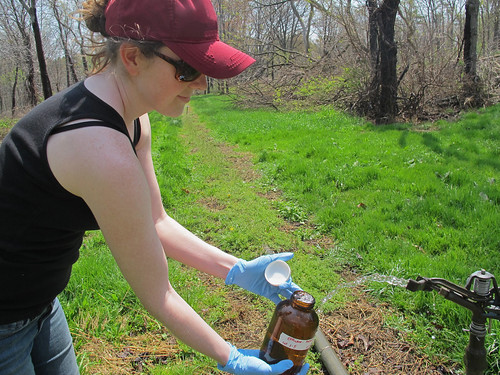By Dennis O'Brien
It’s a question with major public-health implications: Could antibiotics and other widely used medications get into our food supply when they are flushed into our sewers?
To try to answer that question, researchers from USDA and Penn State University (PSU) assessed whether some commonly used pharmaceuticals could get into a wheat crop irrigated with recycled wastewater.
Clinton Williams, a soil scientist with the USDA’s Agricultural Research Service (ARS) in Maricopa, AZ, and Alison Franklin, a Penn State doctoral candidate, along with her PSU adviser Jack Watson, evaluated wheat irrigated with treated wastewater at a specially designed site at University Park, Pennsylvania. The site was spray-irrigated with treated recycled wastewater over a 12-hour period at weekly intervals.

Penn State University doctoral candidate Alison Franklin collects samples of treated wastewater used to spray-irrigate crops at a research site.
It’s difficult to find reliable estimates of how much cropland is being irrigated with recycled water in the United States or overseas. It’s a common practice in parts of California, Arizona, and in Israel and other arid regions around the world. Previous studies have found no risks to human health. But the study by Williams and Franklin was the first to evaluate pharmaceutical-based contaminants found in wheat grown under actual field conditions.
The researchers chose wheat for the study because it is the third most commonly grown cereal grain in the world and the fourth most common U.S. agricultural crop. The wheat produced was harvested for animal feed.
The researchers collected wheat at the site three weeks before the harvest and again during the harvest, separated it into grain and straw, and rinsed it to remove any compounds that might have adhered to plant material. They then analyzed the grain and straw for sulfamethoxazole, trimethoprim, ofloxacin and carbamazepine. The first three are common antibiotics, and the fourth is an anti-seizure medication. Any waterway downstream from a wastewater treatment plant is likely to have at least some levels of the same compounds, Williams said.
The researchers found residues of ofloxacin in the straw and residues of sulfamethoxazole, ofloxacin and carbamazepine in the grain, but not at levels that would make them a health risk. In fact, a person would have to consume up to 200 pounds of the wheat grain in a day to ingest the equivalent of a daily dose of any of the compounds found in medications.
Franklin and Williams say that questions remain about the health effects of long-term exposure to contaminants that enter our waterways, even at very low levels. That’s why the studies are continuing.
Source:usda.gov